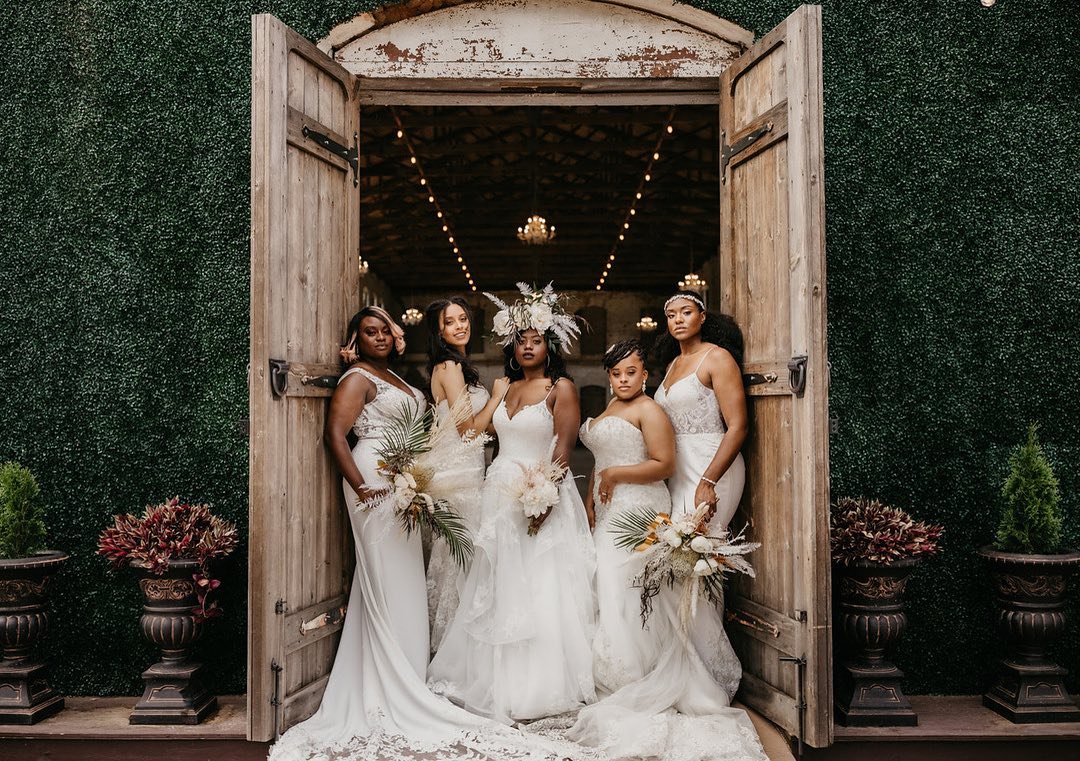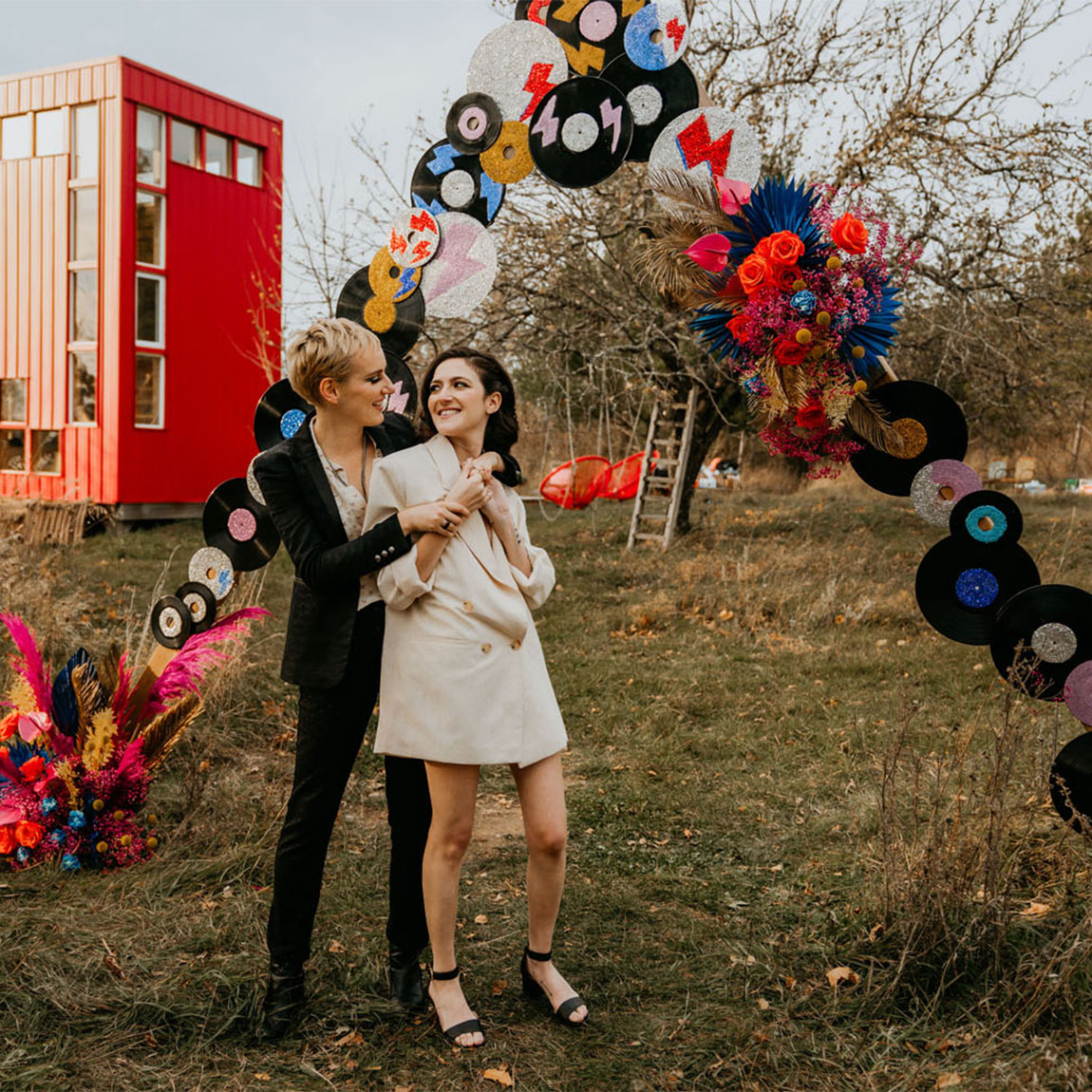
Today is World Day of Social Justice, an international day recognizing the need to promote social justice on issues like poverty, exclusion, gender equality, unemployment, human rights, and social protections. Green Wedding Shoes is committed to promoting change through education and action, specifically within the wedding industry. Today we’re sharing something a little different but a LOT necessary.
{above photo credits: photographer: Avonné Photography | gowns: Gavin Christianson | florals: Designs by Devereux L D Parker Event Designs | makeup: Star Studio | chairs: A Bushel and A Peck Vintage Rentals | video: Tyson and Lenox Films}
Dorian Johnson is a bridal fitness coach who helps brides look + feel their best come the wedding day. He’s here to share a little bit of his experience regarding the threat of racism in the wedding industry and how those involved—specifically wedding professionals—can both be aware and be the change. We’d like to thank Dorian for sharing such invaluable information and proactive resources to make our industry a beautiful home for all couples, as it should be.
///
As a fitness and body image coach for brides-to-be, it is my mission that all who identify as such feel safe, well, and comfortable in their bodies. When racism is a threat to the bridal experience, it has a direct effect on what should be a safe and hopeful time.
Reducing the threat of racism helps BIPOC to-be-weds feel comfortable, seen, and valued. It is common to feel mentally trapped and unable to appropriately respond to emotions that arise in the face of racism. Mental health then negatively affects physical health, inhibiting performance due to lack of focus.
With that said, let’s take a look at four ways racism shows up in the wedding space.
*Disclaimer, to make any lasting, worthwhile change…discomfort will result. I encourage you to sit with it and become curious about your feelings.*
Racism appears in a lack of diversity and inclusion.
Diversity and inclusion are popular buzzwords nowadays and are often paired together, but they mean different things. Let’s quickly define them.
Diversity refers to a range of people from different backgrounds being represented. It can extend to gender identity, body size, sexual orientation, and ability.
A common misconception is that just including various groups is enough to “do your part.” But,to borrow a quote from Verna Myers, diversity is “being invited to the party; inclusion is being asked to dance.”
Inclusion is when people of different groups enter a space and feel welcomed, respected, and safe.
This is the tricky part. When a group is invited to enter a space, was it created a) with that group in mind or b) as an afterthought—where they’re expected to “just fit in” and make themself comfortable?
In that context of a dance, is your wedding space one where to-be-weds are holding the wall while watching others get priority, resulting in a poor experience? This is what is known as a microaggression: everyday actions (or words) that are hostile, demeaning, and negative toward a person or group.
As a wedding professional, it’s essential to consider microaggressions a bride-to-be might be experiencing from unchecked biases in your circle. The thing about microaggressions is that they’re small, they’re subtle, and they can be unintentional and indirect. But they still hurt, and do a great deal of damage to psychological health.
In the event of a microaggression, the person is generally present but with a disconnected feeling in terms of involvement and consideration. Specifically, in the wedding industry, BIPOC can tell when they are an afterthought when venues/shops/events/brands don’t operate with an intentionally diverse and inclusive lens.
Try this eye-opening practice, inspired by Dr. Larissa Mercado-Lopez. Do a Google image search for “happy bride.” What do you see? Look among the most popular results and dissect the similarities among them. Then notice the differences.
Is it in hair, whether length or color? Or perhaps it’s the style of the brides’ dresses. Maybe there’s a noticeable difference in partners.
From these results, we can deduce that 1. they define what a happy bride is and what they look like, and 2. they tell us what a happy bride is not.
Many may claim that images do not affect their own self-perception. However, feminist media scholar Jean Kilbourne argues that the conscious mind can only assess 8% of an image’s message. This means that 92% of the meaning behind an image is processed unconsciously.
Next, consider your favorite wedding blog, Instagram profile, bridal magazine, or TV show that revolves around weddings. They likely match the visuals of the Google search result.
The seemingly harmless images now shape and reinforce beliefs about race, promoting a “right way” to be a bride, intentional or not.
Racism appears by way of tokenism.
If lack of representation is driving, tokenism is in the passenger seat. Tokenizing is when individuals, companies, and/or other platforms center a non-white person in a position of power to deflect calls of racism or discrimination.
In the wedding industry, it could show up as having a “black bride” on the cover of a magazine during a specific month, such as Black History Month. Or in describing a woman who doesn’t adhere to common westernized eurocentric standards, with an obscure descriptor such as “exotic beauty” to temporarily deviate from the status quo.
Just as BIPOC can tell when a space treats them as an afterthought, they can tell when a gesture isn’t genuine. It’s symbolic, manufactured, and performative. Why give the appearance of racial (or sexual) equality when you can take authentic action to create it?
If you have a platform as a wedding professional, you have an opportunity. Visually highlighting BIPOC isn’t enough. You must amplify their voices and content. Build relationships and connect with others. Who is better to share their experiences? With social media, it’s easier than ever to seek out complementary wedding pros to collaborate and amplify.
Racism appears when you are complicit.
Racism commonly shows itself in the wedding space through the act of complicity. This is most apparent when brands respond to acts of racism, white supremacy, and mistreatment of marginalized groups with silence. A silence that stems from the fear of upsetting or potentially losing followers or partnerships—or the plain fact that their own views are similar.
Weddings are generally symbolic of union, love, and an exciting future in a new life with a partner. Remaining silent about issues that threaten a specific demographic in those very areas is, to say the least, alarming.
Remember that emotional and mental health is impacted by racism. If a BIPOC doesn’t know where your company stands on issues that threaten their well-being, it is directly upholding racism and simultaneously causing harm by not speaking out. Opting out and not engaging on such matters is wielding privilege—and foregoing the ability to be an ally when it really matters.
Racism appears through elitism.
Elitism can be defined as fashioned and/or privileged above others. Consider your findings from the Google exercise and let’s analyze. The search established what a “happy bride” looks like:
a slender, white, feminine presenting woman with no visible disabilities who appears to have the financial means to afford a lavish, luxurious wedding.
This inherently introduces a divisive hierarchy. The brides in the Google search are now elevated, or “elite,” and all others are suppressed. They are deemed what I call “outside brides,” i.e not belonging to or coming from within a particular group. And this, all from a search result.
To the brides-to-be that don’t and can’t fit the narrow definition—what is to be of them? How are they to feel? Excluded, yes. But there is even more to it that can result in lower self-esteem, confidence, and body image issues. Research has shown that we subconsciously prefer the body types we see most often. This confirms yet another way in which mental health is subtlety impacted, intentional or not.
It’s time to demand that the wedding space is safe for everyone and all groups—especially those who face the most discrimination. Being diverse isn’t enough. Tokenism is performative. But collectively, we can educate ourselves in the insidious ways racism shows up in the wedding industry and take action to create a more inviting environment. Here’s how.

{photo credits: photographer: Elizabeth Messina | dress: Claire Pettibone | hmu: Gina Brooke | florals: Forage Florals | model: Sophia Bernard }
How to be Anti-Racist in the Wedding Industry:
There are a number of actions we can take to authentically create a more inclusive wedding space.
- Check your own biases.
According to the Kirwan Institute for the Study of Race and Ethnicity, implicit bias is an attitude or stereotype we perceive that affects our understanding, actions, and decisions in an unconscious manner. It’s human nature to have them. But where it gets problematic is when implicit biases cause you to perform micro (or even macro) aggressions.
When you recognize how racist tendencies show up to you personally, you can be more aware of how it could show up among your staff or in your brand as a whole. This bias can influence the experience a person of color will have with your business. If the goal is to create a more inclusive, welcoming wedding space, it is imperative that you challenge your own biases.
- Share your business values.
My personal business values are autonomy, empowerment, diversity and inclusion, authenticity over approval, and fun. To prospective folks seeking me out, they can tell from my marketing materials, graphics, content, and values that they are not only invited to the party but to dance as well.
Being upfront with your principles extends the invitation. It makes it easier for prospects to find someone who shares their values. Most importantly, they’ll be more likely to interact with you while feeling safe, seen, and appreciated.
- Take inventory of your business.
This is a worthwhile exercise. You can ask yourself questions including, but not limited to:
- Do my materials represent diversity of body shape, ability, age, race, gender expression, etc.?
- Do my staff and I have proficiency in my clients’ preferred languages?
- How diverse is my space? Do I possess the means to make change?
- Do I provide information, services, and/or resources that are accessible to a wide range of income levels?
- Intentionally create a safe culture.
It’s one thing to say “everyone is welcome” as a wedding brand or professional, but does everyone who occupies that space feel welcomed? Are there explicitly stated rules in a code of conduct or an anti-racism and diversity inclusion policy? If so, does all staff know, agree, and adhere to it? Are there expectations set where everyone knows what will and will not be tolerated? In the event of a violation, is it clear to know how things will be handled?
When everyone involved is aware of policies in place, it creates a safe place where anyone can be engaged and fulfilled in the process.
There’s a difference between saying, “everyone is welcome here” and “We’ve intentionally created a space for BIPOC and other marginalized groups to have an enjoyable experience. {This} is the expected standard and in the event that a violation occurs, {this} is how it will be handled.”
- Practice cultural competence.
This simply means that you and staff can:
- Interact effectively with people from different cultures,
- Respect and respond to different people’s needs, beliefs, and practices, and
- Work to learn about cultures that aren’t your own.
When you can acknowledge someone else’s lived experience, it shows respect, inclusion, and builds trust.
Sitting with temporary discomfort can lead to lasting change when you implement these steps. When we collectively take intentional action, we can move in the direction of creating a more inclusive, diverse, safe, and equitable wedding industry to be proud of. It’s not truly a safe space until it’s safe for everyone.
Follow Dorian on Instagram at @bridalarchitect

